
Shiprock, the sacred mountain of the Navajo, New Mexico.
The Old New Mexico - part 6
At the time of European arrival, most of New Mexico was occupied
by two closely related tribes - the Navajo and the Apache. Both have migrated
from Canada around 1400 AD. Their relations with the Pueblo Indians were a complex
combination of raiding and trading, but they gradually shifted towards raiding
as the pueblos' population declined following the Spanish invasion. Unlike the
sedentary Pueblo people, they were generally hated by the Americans and subjected
to genocide, ethnic cleansing, forced relocations and cultural oppression.
 |
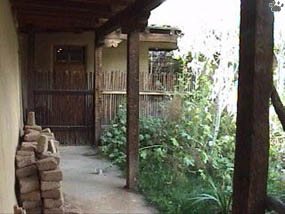 |
| House of Kit Karson, leader of 1863
extermination campaign against the Navajo, is now a museum. Taos, New Mexico. |
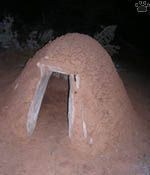
Traditional sweat lodge, Navajo
National Monument, Arizona. |
Since the 17th century, the Navajo
have been predominantly sheep herders. They lived in small family groups, mostly
in framed adobe houses called hogans. After the US Army invaded their lands
(1840-1886), they were forced to march to the deserts of eastern New Mexico. Those
who survived were later allowed to return. Many Navajos still maintain traditional
lifestyle, and most speak Navajo language. |
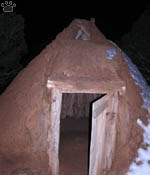
Traditional hogan, Navajo
National Monument, Arizona. |
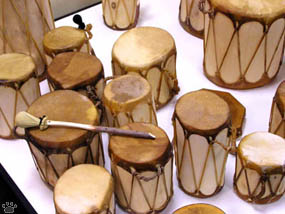
Navajo drums for sale, Alamo, New Mexico. |

Navajo rugs for sale, Ramah, New Mexico. |
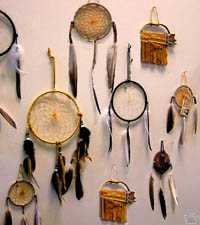
Navajo dreamcatchers for sale, Canoncito,
New Mexico. |
Today the Navajo are the largest native
tribe in North America (~150,000 people). They live in one very large reservation
and a number of small ones in northeastern Arizona, northwestern New Mexico, and
extreme southeastern Utah. Their most famous arts are jewelry-making and weaving. |
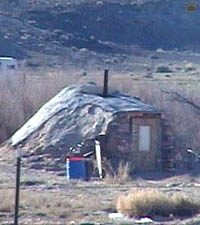
Hogans and sweatlodges are still a common
sight on Navajo lands. Sanostee, New Mexico. |
 |
 |
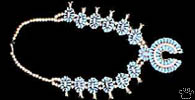 |
 |
 |
| Contemporary Navajo jewelry, Window
Rock, New Mexico. |
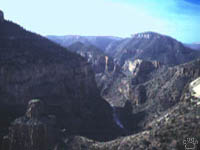
Apache lands, San Carlos Indian Reservation, Arizona. |
The Apache once inhabited a huge territory,
from Texas to Arizona. They helped the USA in its war with Mexico, but were later
betrayed, and fought a bloody guerilla war against US troops. Many were exiled
to Oklahoma. |
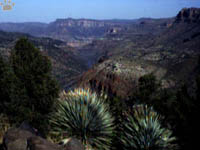
Former Apache lands, Gila River Valley,
New Mexico. |
 |
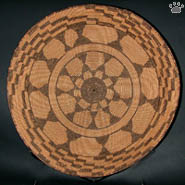 |
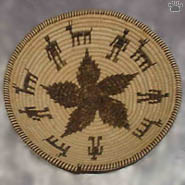 |
| Apache baskets, Jicarilla Apache
Reservation. |
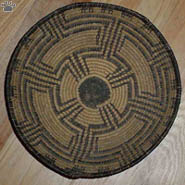
Apache baskets, Jicarilla Apache
Reservation. |
Now most Apaches live in southeastern Arizona,
but there are also two reservations in New Mexico. Logging, cattle raising, and
tourism are the main sources of income. The Apaches are less involved in souvenir
industry than other New Mexican tribes; they make excellent baskets and some pottery.
|

Apache baskets, Jicarilla Apache
Reservation. |
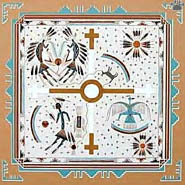 |
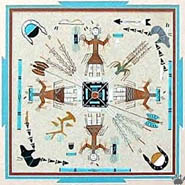 |
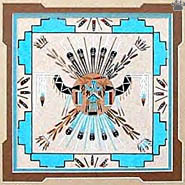 |
| Contemporary Navajo sandpaintings. |

Contemporary Navajo sandpainting. |
Probably the most interesting and unique artform
of Navajo and Apache people are sandpaintings. Originally they were made for religious
and healing ceremonies, and then destroyed. |
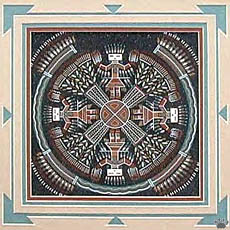
Contemporary Navajo sandpainting. |
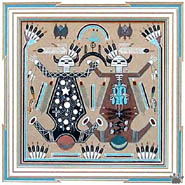 |
 |
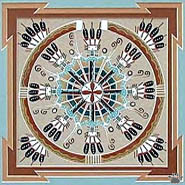 |
| Contemporary Navajo sandpaintings. |
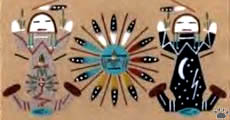
Contemporary Navajo sandpainting. |
In the 1940-s, the Navajo began to create permanent
sandpaintings in order to preserve the tradition and earn income. |

Contemporary Apache sandpainting. |
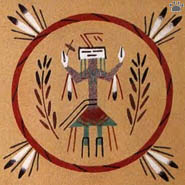 |
 |
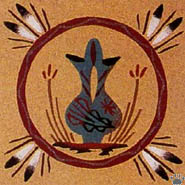 |
| Contemporary Navajo sandpaintings. |
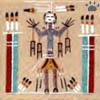
Contemporary Navajo
sandpainting. |
The designs of "commercial" paintings
are slightly altered, so that they don't have any religious significance and can
be viewed by strangers. They are, however, splendid works of art. They are made
by slowly hand-trickling colorful sand (made by grinding down rocks of various
kinds) onto epoxy-covered boards. Making them is much more difficult than it seems,
and requires a lot of practice. |

Contemporary Navajo
sandpainting. |
 |
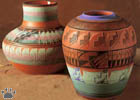 |
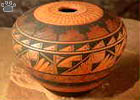 |
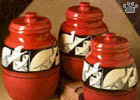 |
| Ute pottery, Towaoc, Ute Mountain
Reservation. |

Ute pottery, Ute Mountain
Reservation. |
Ute Indians' territory once included much of Utah
and Colorado. They are the descendants of the ancient Fremont Culture. They were
mostly hunters-gatherers, but also practiced some agriculture. Now they have three
reservations. One of them includes a small area in extreme northwestern New Mexico.
Mineral leases are the main source of income. Traditional Ute arts are basketry
and beadwork, but their pottery, influenced by pueblo style, is also good. |

Ute pottery, Ute Mountain
Reservation. |
 |
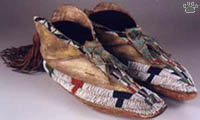 |
 |
 |
| Kiowa bags and moccasins, 19th century,
Metropolitan Museum, New York. |

Comanche pipe, Cedar
Breaks SP, Texas. |
The original inhabitants of the eastern plains
of New Mexico were the Apache and Kiowa people. In the 17th century, horses
acquired from the Spanish made bison hunting easy, and many tribes migrated to the Great Plains. The Comanche moved from the Rocky Mountains.
They fought off the Spanish and the French, but lost all
their land to the US, and were confined to reservations in Oklahoma. Very little
evidence of Kiowa and Comanche presence remains in New Mexico today. Native culture
has survived in New Mexico to a greater degree than in any other state, but
even here the cultural loss has been enormous and tragic. |
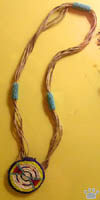
Comanche necklace,
Cedar Breaks SP. |
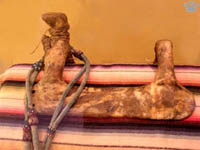 |
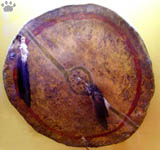 |
 |
| Comanche saddle, shield, and leather
bag, c. 1850, Cedar Breaks State Park, Texas. |
|
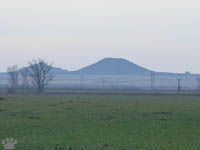
Medicine Mound, a sacred Comanche site,
Texas.
|
As for the Anglo-Americans, there cultural
achievements in the Southwest have so far been modest. Will they ever
create a culture as original and colorful as the ones they destroyed? Only time
will tell. |

Aerial view of Albuquerque,
the largest city of New Mexico. |

Cats and mouse, contemporary pottery, Zia Pueblo. |
Back to Part 5
Home
|